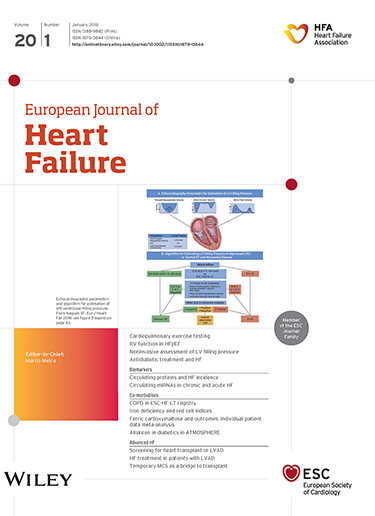Improved risk assessment in parvovirus B19‐positive patients with heart failure by multiparametric analysis of endomyocardial biopsy using machine learning methods
IF 10.8
1区 医学
Q1 CARDIAC & CARDIOVASCULAR SYSTEMS
引用次数: 0
Abstract
AimsThe analysis of endomyocardial biopsies (EMB) is a prerequisite for a definitive diagnosis in patients with unexplained heart failure (HF). The use of machine learning (ML) methods may help to identify high‐risk patients and to initiate therapy. In this study, we develop ML models for risk stratification of parvovirus B19 (B19V) positive patients with HF based on key features from multiparametric EMB analyses.Methods and resultsWe retrospectively enrolled 263 B19V‐positive patients with HF (mean age 51 ± 15 years, 62% male) and followed them over a median period of 22 months (interquartile range 4–35 months). All‐cause mortality, left ventricular (LV) deterioration and persistent LV systolic dysfunction were used as clinical combined endpoint. EMB were analysed for a variety of inflammatory and infectious markers, and patient prognosis was assessed using ML methods (logistic regression, random forest, support vector machines and gradient boosting). Detection of intramyocardial inflammation and B19V viral activity was associated with poor clinical outcome (hazard ratio 3.50, 95% confidence interval 1.96–6.23,使用机器学习方法进行心内膜心肌活检的多参数分析,改善细小病毒B19阳性心力衰竭患者的风险评估
目的对不明原因心力衰竭(HF)患者进行心内膜活检(EMB)分析是明确诊断的先决条件。使用机器学习(ML)方法可能有助于识别高风险患者并启动治疗。在这项研究中,我们基于多参数EMB分析的关键特征,开发了用于小病毒B19 (B19V)阳性HF患者风险分层的ML模型。方法和结果回顾性纳入263例B19V阳性HF患者(平均年龄51±15岁,男性62%),随访时间中位数为22个月(四分位数间距4-35个月)。全因死亡率、左室(LV)恶化和持续性左室收缩功能障碍作为临床联合终点。EMB分析各种炎症和感染标志物,并使用ML方法(逻辑回归、随机森林、支持向量机和梯度增强)评估患者预后。心内炎症和B19V病毒活性检测与不良临床结果相关(风险比3.50,95%可信区间1.96-6.23,p <;0.001)。与使用单一特征(AUC = 0.667)相比,人口统计学和临床数据与多参数EMB标记物的线性组合提高了预后表现(曲线下面积[AUC] = 0.724)。梯度增强ML方法显著提高了风险预测的准确率(AUC = 0.926)。结论心肌炎和B19V病毒活性在临床预后较差的患者中较高,提示它们是死亡和左室功能障碍的危险因素。使用多参数EMB数据,我们提出了一种基于ML的预后工具,可以高度准确地确定患者的临床结果。这可能有助于评估疾病的进展并做出适当的治疗决定。
本文章由计算机程序翻译,如有差异,请以英文原文为准。
求助全文
约1分钟内获得全文
求助全文
来源期刊

European Journal of Heart Failure
医学-心血管系统
CiteScore
27.30
自引率
11.50%
发文量
365
审稿时长
1 months
期刊介绍:
European Journal of Heart Failure is an international journal dedicated to advancing knowledge in the field of heart failure management. The journal publishes reviews and editorials aimed at improving understanding, prevention, investigation, and treatment of heart failure. It covers various disciplines such as molecular and cellular biology, pathology, physiology, electrophysiology, pharmacology, clinical sciences, social sciences, and population sciences. The journal welcomes submissions of manuscripts on basic, clinical, and population sciences, as well as original contributions on nursing, care of the elderly, primary care, health economics, and other related specialist fields. It is published monthly and has a readership that includes cardiologists, emergency room physicians, intensivists, internists, general physicians, cardiac nurses, diabetologists, epidemiologists, basic scientists focusing on cardiovascular research, and those working in rehabilitation. The journal is abstracted and indexed in various databases such as Academic Search, Embase, MEDLINE/PubMed, and Science Citation Index.
 求助内容:
求助内容: 应助结果提醒方式:
应助结果提醒方式:


